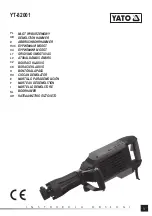
INSTALLATION
Page 15
MAIN CIRCUIT CABLE CONNECTIONS
Cables which connect to the circuit breaker
should be routed to avoid interference with sharp
edges and moving parts. Minimum bending
radius for the type of cable used should be
observed.
Power cables should be braced and/or laced to
withstand short-circuit forces wherever such
cables are unsupported. Power cables should
be adequately sized to carry the maximum
continuous current in accordance with NEC
requirements and should have an adequate
voltage rating. Cables should be dressed and
terminated as appropriate to the voltage class
and cable manufacturer’s recommendations.
When terminating shielded cables, use
termination kits appropriate for the system
voltage to taper the insulation and reduce
electrical stress. Follow the manufacturer’s
installation instructions provided with the
termination kit.
To connect cables, follow the steps below:
1. Pass the cable through the insulating
cylinder (six cylinders are supplied with the
circuit breaker) (Fig. 15).
2. Fasten the cable to the main circuit terminal
(Fig. 16). Use 35 mm Class 8.8 M10 or M12
hex head bolts, 2 flat washers, a lock
washer and a nut. While securely preventing
the bolt from rotating with a wrench, torque
the nut to 250-315 kgf-cm (18-23 ft-lb) for
M10 bolts or 450-565 kgf-cm (32-41 ft-lb) for
M12 bolts.
Use two wrenches to torque
the connection to prevent
applying excessive force to
the terminal which can
damage the frame.
3. Fasten the insulating cylinder in place, then
check to make sure that the hook is engaged
(Fig. 17).
Fig. 15 Pass Cable Through Insulating
Cylinder
Fig. 16 Fasten Cable to Main Circuit
Terminal
Fig. 17 Fasten Insulating Cylinder
CAUTION
















































